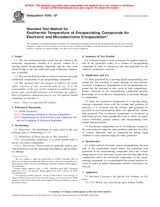Wir benötigen Ihre Einwilligung zur Verwendung der einzelnen Daten, damit Sie unter anderem Informationen zu Ihren Interessen einsehen können. Klicken Sie auf "OK", um Ihre Zustimmung zu erteilen.
ASTM F542-07
Standard Test Method for Exothermic Temperature of Encapsulating Compounds for Electronic and Microelectronic Encapsulation (Withdrawn 2013)
Automatische name übersetzung:
Standard Test Method for exotherme Temperatur von Vergussmassen für die elektronischen und mikroelektronischen Kapselung (Withdrawn 2013)
NORM herausgegeben am 1.5.2007
Informationen über die Norm:
Bezeichnung normen: ASTM F542-07
Anmerkung: UNGÜLTIG
Ausgabedatum normen: 1.5.2007
SKU: NS-55656
Zahl der Seiten: 3
Gewicht ca.: 9 g (0.02 Pfund)
Land: Amerikanische technische Norm
Kategorie: Technische Normen ASTM
Die Annotation des Normtextes ASTM F542-07 :
Keywords:
electronic, encapsulating compounds, exothermic temperature, microelectronic encapsulation, ICS Number Code 31.240 (Mechanical structures for electronic equipment)
Ergänzende Informationen
| Significance and Use | ||||
|
Heat generated by a reacting liquid encapsulating compound has the potential to cause damage to heat-sensitive electronic components. Degradation of the encapsulating compound has the potential to also occur at high temperatures. Proper selection of an encapsulating compound includes knowledge of its exothermic temperature to preclude damage to components. Since the exothermic temperature of a reacting encapsulating compound varies with the volume and geometry of material, it is essential that the volume and geometry be specified in any determination. Select the appropriate volume and geometry. The exothermic temperature is measured in sufficiently precise and reproducible form to allow for application evaluation, quality control, and encapsulating compound characterization. Exothermic temperature rise of two different volumes of the same material using the same geometry indicates the effect of volume. Materials may be compared by testing equal volumes of each material using the same geometry. |
||||
| 1. Scope | ||||
|
1.1 This test method provides results that are related to the maximum temperature reached in a specific volume by a reacting liquid encapsulating compound, and the time from initial mixing to the time when this peak exothermic temperature is reached. 1.2 This test method provides a means to measure the peak exothermic temperature of an encapsulating compound. This standard does not purport to address all of the safety concerns, if any, associated with its use. It is the responsibility of the user of this standard to establish appropriate safety and health practices and determine the applicability of regulatory limitations prior to use. For specific hazard statements see Section 8. Note 1There is no equivalent IEC standard. |
||||
| 2. Referenced Documents | ||||
|



 Cookies
Cookies
